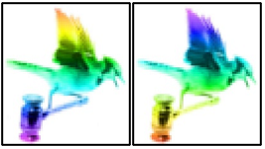
Trademark description: The trademark consists of a hologram of a pixelated blue jay holding a gavel as depicted in the visual representation. The visual representation depicts different views of the same trademark. The trademark has a holographic rainbow colour effect and the applicant claims the colours red, orange, yellow, green, blue, indigo, violet as a feature of the trademark.
Holographic Blue Jay Design, Application No. 2169305
Canadian Trademarks Database
On June 17, 2019, the Canadian Intellectual Property Office (CIPO) opened its doors to accepting applications for a broader range of “non-traditional” trademarks such as those consisting in whole or in part of a hologram. As of the time of writing, only 33 applications have been filed designating a hologram as the type of trademark, and surprisingly, only one application was filed with the help of a Trademark Agent.
Shortcomings of Previously Filed Applications
Perhaps understandably, then, the applications that were not filed through a Trademark Agent will most likely be objected to for failing to include, among other things:
- a visual representation in the form of one or more still images, sufficient in number and clarity, to demonstrate the holographic effect in its entirety; or
- a clear and concise description of the visual effect when the hologram is viewed from different angles.
These are two requirements unique to trademark applications for holograms pursuant to a Practice Notice published by CIPO on June 17, 2019 (the “Practice Notice”). Notably, the Practice Notice provides the following example of an acceptable description of a hologram trademark:
“The trademark consists of a hologram of a dove in flight. The visual representation included in the application depicts the full range of the holographic effect.” (Emphasis added)
Unfortunately, a brief review of the applications reveal that many applicants merely provided a title, a business description, and even a plea to the examiner to approve their application, instead of describing the holographic effect of their trademark.










